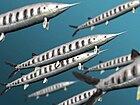
Semionotiformes is an order of ray-finned fish known from the Middle Triassic (Anisian) to the Late Cretaceous (Maastrichtian). Their closest living relatives are gars (Lepisosteidae), with both groups belonging to the clade Ginglymodi within the Holostei. The group includes both freshwater (Semionotidae) and marine adapted forms. Many members of the family Macrosemiidae, had elongated dorsal fins, often associated with an adjacent area of skin which was free of scales. These fins were likely undulated for use in precision swimming. The body morphology of macrosemiids suggests that they were slow swimmers that were capable of maneuvering around complex topography, such as reef environments.

Sclerorhynchus is an extinct genus of ganopristid sclerorhynchoid that lived during the Late Cretaceous. The genus Ganopristis is considered a junior synonym of Sclerorhynchus. It was a widespread genus, with fossils found in the Middle East, North Africa, Europe, and North America. While it had a long rostrum with large denticles similar to sawfishes and sawsharks, its closest living relatives are actually skates. Complete specimens of S. atavus show that its fin arrangement was similar to skates, with the pectoral and pelvic fins touching, both dorsal fins located behind the pelvic fins, and a reduced caudal fin.

Protosphyraena is a fossil genus of swordfish-like marine fish, that thrived worldwide during the Upper Cretaceous Period (Coniacian-Maastrichtian). Though fossil remains of this taxon have been found in both Europe and Asia, it is perhaps best known from the Smoky Hill Member of the Niobrara Chalk Formation of Kansas. Protosphyraena was a large fish, averaging 2–3 metres in length. Protosphyraena shared the Cretaceous oceans with aquatic reptiles, such as mosasaurs and plesiosaurs, as well as with many other species of extinct predatory fish. The name Protosphyraena is a combination of the Greek word protos ("early") plus Sphyraena, the genus name for barracuda, as paleontologists initially mistook Protosphyraena for an ancestral barracuda. Recent research shows that the genus Protosphyraena is not at all related to the true swordfish-family Xiphiidae, but belongs to the extinct family Pachycormidae.

Camille Arambourg was a French vertebrate paleontologist. He conducted extensive field work in North Africa. In the 1950s he argued against the prevailing model of Neanderthals as brutish and simian.

Carcharias is a genus of mackerel sharks belonging to the family Odontaspididae. Once bearing many prehistoric species, all have gone extinct with the exception of the critically endangered sand tiger shark.
René Lavocat was a French palaeontologist who described several genera of African dinosaurs including the sauropod Rebbachisaurus, as well as several extinct mammals such as the family Kenyamyidae. The mammal Lavocatia, the notosuchian Lavocatchampsa, the sauropod Lavocatisaurus and the phorusrhacid Lavocatavis are named after him.
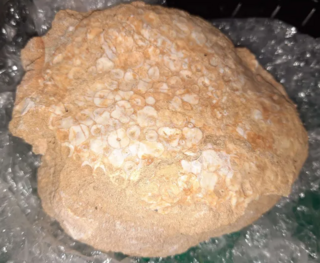
Eodiaphyodus is a genus of Elopiform fish that is classified in the suborder Albuloidea. It is known from Late Cretaceous sediments across Africa, and it crushed its food with bony plates found in the back of its throat. The type species is E. granulosus and it was named and described in 1952.
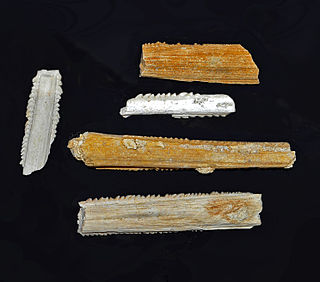
Rhombodus is a prehistoric genus of ray belonging to the family Rhombodontidae.

Aidachar is an extinct genus of marine ichthyodectiform teleost ray-finned fish from the Late Cretaceous (Cenomanian-Turonian) of Central Asia and North Africa.

Acrotemnus is an extinct genus of marine pycnodontid ray-finned fish from various areas of the Tethys Sea that lived during the Turonian stage of the Upper Cretaceous. The genus comprises three species A. faba, A. streckeri, and A. megafrendodon.
Scanilepis is an extinct genus of prehistoric bony fish that lived during the Rhaetian-?Hettangian ages. The type species, S. dubia, is known from the Rhaetian freshwater deposits of the Bjuv member of the Höganäs Formation, southwestern Sweden. A second species, S. spitzbergensis was mentioned from the Hettangian of the Festning section of the Grøfjorden area in Spitsbergen, Norway but was never described.

Anaethalion is an extinct genus of prehistoric marine and freshwater ray-finned fish related to modern tarpons and ladyfish. It is known from the Late Jurassic to the Early Cretaceous of Europe and northeasterrn Asia, roughly encompassing the Tethys Ocean.
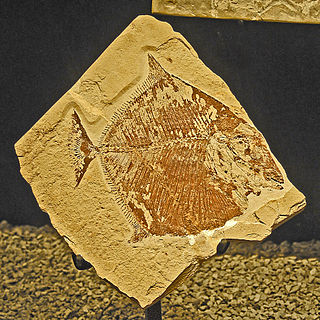
Palaeobalistum is an extinct genus of prehistoric ray-finned fish which ranged from the Cretaceous to Eocene periods.
Enteromius arambourgi is a species of ray-finned fish in the genus Enteromius. It is endemic to Ethiopia.

Atractosteus is a genus of gars in the family Lepisosteidae, with three species. The genus first appeared in the Campanian in the Late Cretaceous.
Pattersonellidae is an extinct family of primitive ray-finned fish. It is tentatively classified under the suborder Argentinoidei of the order Argentiniformes.

Cretalamna is a genus of extinct otodontid shark that lived from the latest Early Cretaceous to Eocene epoch. It is considered by many to be the ancestor of the largest sharks to have ever lived, such as Otodus angustidens, Otodus chubutensis, and Otodus megalodon.
Chuhsiungichthys is an extinct genus of ichthyodectiform ray-finned fish that lived in freshwater environments in what is now Yunnan, China, and Kyushu, Japan, during the Cretaceous. It differs from its sister genus, Mesoclupea, primarily by having a comparatively more anteriorly-placed dorsal fin.
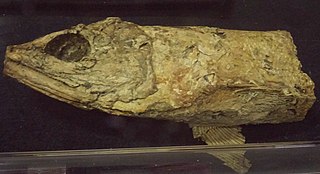
Goulmimichthys is an extinct genus of ray-finned fishes in the family Pachyrhizodontidae. The genus, first described by Cavin in 1995, is known from various Turonian age formations. The type species G. arambourgi from the Akrabou Formation in the El Rachidia Province of Morocco, and other fossils described are G. gasparini of the La Frontera Formation, Colombia, and G. roberti from the Agua Nueva Formation of Mexico.
Ganopristidae is an extinct family of cartilaginous fish from the Cretaceous belonging to the suborder Sclerorhynchoidei. While the name Sclerorhynchidae is often used for this family, it is a junior synonym of Ganopristidae. This family contains the genera Libanopristis, Micropristis, and Sclerorhynchus. The type genus Ganopristis is considered to be a junior synonym of Sclerorhynchus.

















